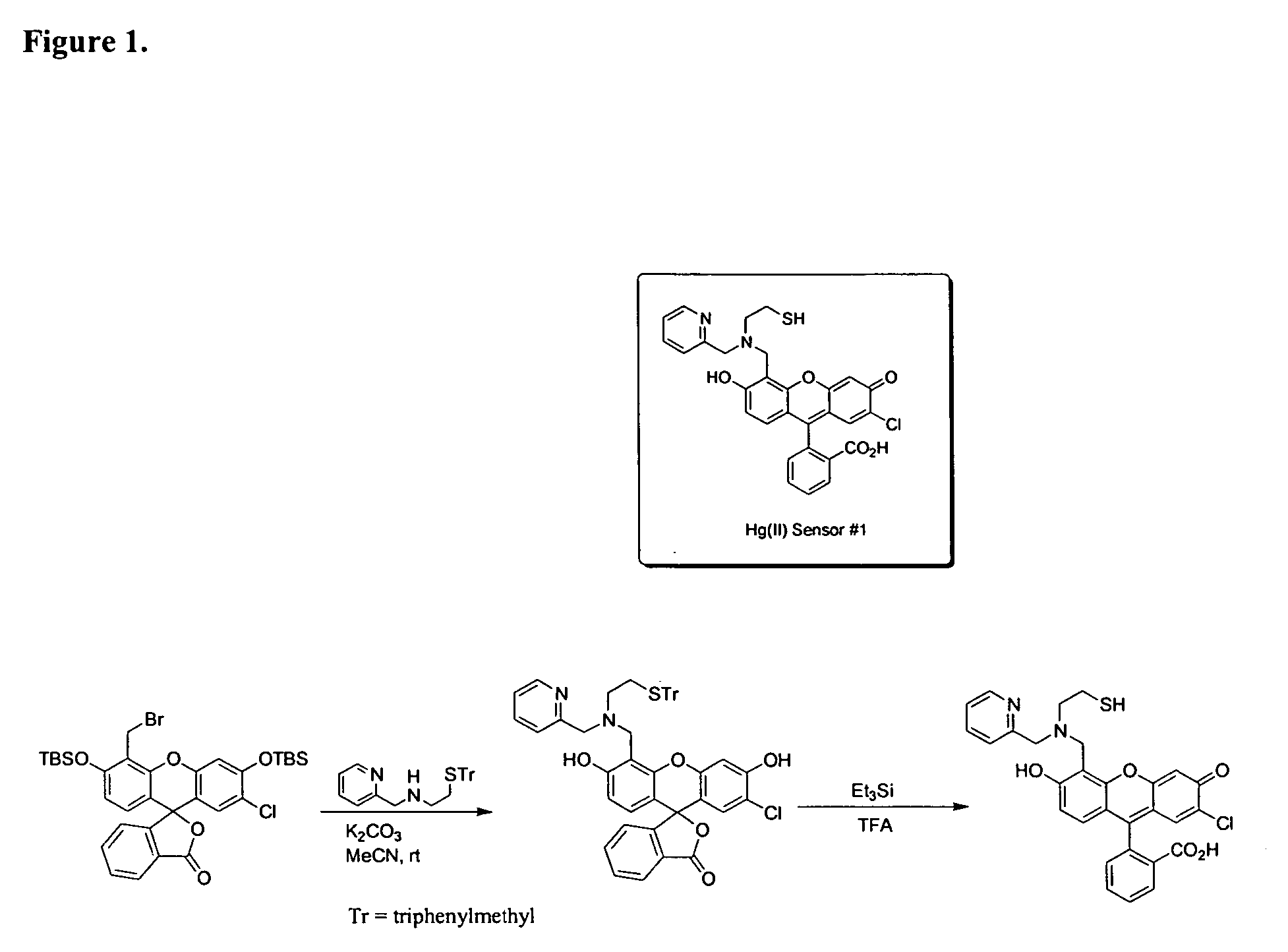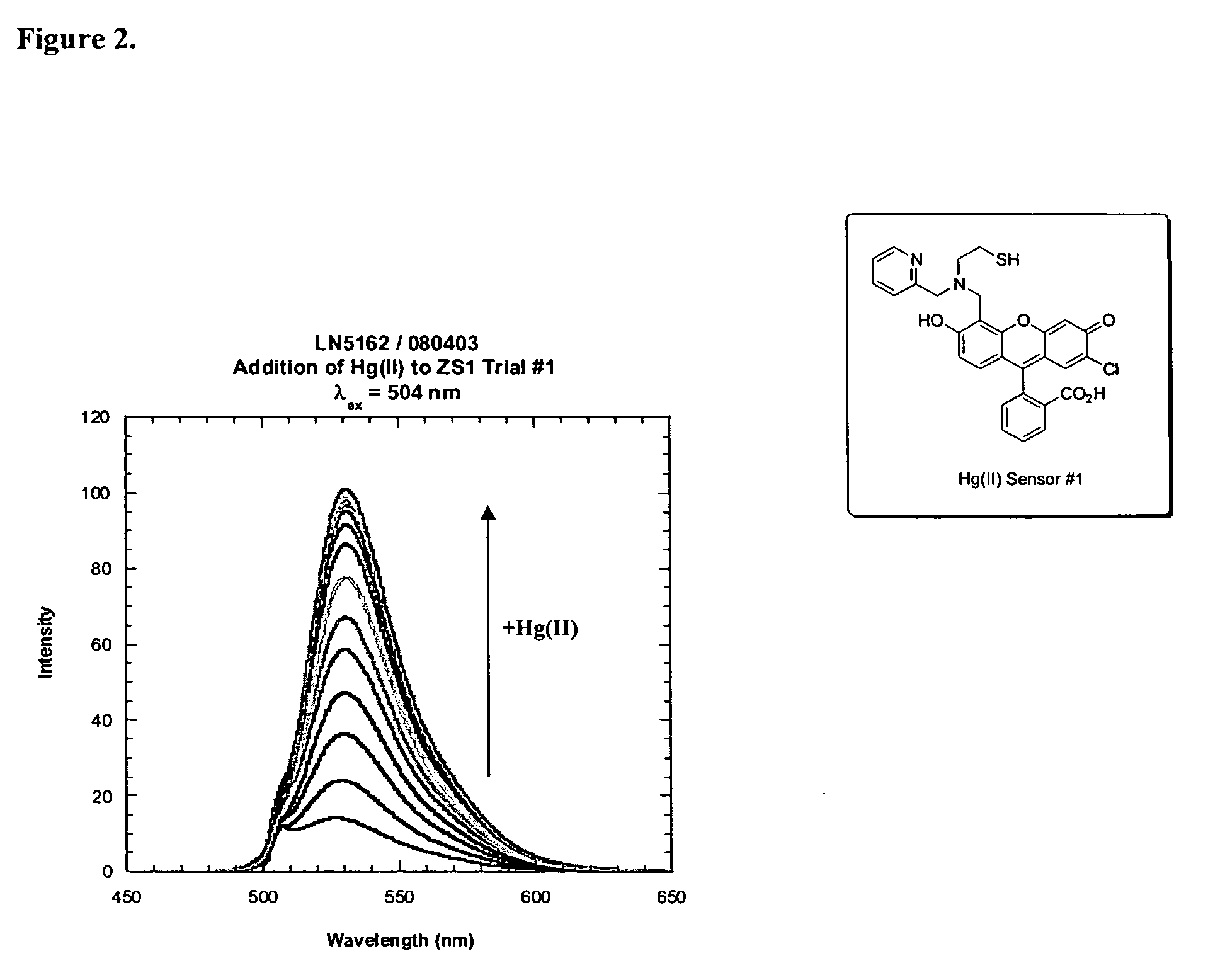Fluorescein-based metal sensors, and methods of making and using the same
a technology of fluorescein and metal sensors, applied in the field of fluorescein-based metal sensors, and methods of making and using the same, can solve the problems of high toxic thallium(i) in natural waters, limited practicality of fluorescence technology for a particular application, and high risk of human health and the environmen
- Summary
- Abstract
- Description
- Claims
- Application Information
AI Technical Summary
Benefits of technology
Problems solved by technology
Method used
Image
Examples
example 1
[0192] Reagents. Ethyl acetate (EtOAc) was dried over 3 Å molecular sieves. 1,2-Dichloroethane (DCE) was distilled from calcium hydride under nitrogen and stored over molecular sieves. Acetonitrile was either distilled over CaH2 under nitrogen or was saturated with Ar and dried by passing through an activated Al2O3 column. 3,9-Dithia-6-azaundecane was synthesized as previously described. All other reagents were used as received.
example 2
[0193] Methods. Silica gel-60 (230-400 mesh) was used as the solid phase for flash chromatography and thin layer chromatography (TLC) was performed by using Merck F254 silica gel-60 plates. TLC plates were visualized with UV light or after developing with ninhydrin stain. 1H and 13C NMR spectra were obtained either on a Varian 300 MHz or a Varian 500 MHz spectrometer operating at ambient probe temperature, 283 K, and referenced to internal probe standards. IR spectra were recorded by using an Avatar 360 FTIR instrument. Electrospray ionization (ESI) spectroscopy was performed in the MIT Department of Chemistry Instrumentation Facility.
[0194] Examples 3 through 5 are depicted in the schematic of FIG. 13.
example 3
[0195] N-(2-Nitrobenzyl)-3,9-dithia-6-azaundecane (1). 2-Nitrobenzylbromide (560 mg, 2.59 mmol), K2CO3 (400 mg, 2.89 mmol) and molecular sieves were combined in 25 mL of CH3CN and stirred. A 10 mL solution of 3,9-dithia-6-azaundecane (501 mg, 2.59 mmol) in CH3CN was added dropwise. The reaction was stirred for 8 h, filtered through Celite and the solvent was evaporated to afford a yellow oil. The oil was flushed through a short silica plug (7:1 hexanes:EtOAc) and dried to yield the product (726 mg, 85%). TLC Rf=0.38 (silica, 7:1 hexanes:EtOAc). 1H NMR (CDCl3, 300 MHz) δ13C NMR (CDCl3, 125 MHz) δ 14.86, 26.03, 29.06, 54.03, 55.55, 124.10, 127.65, 130.68, 132.35, 134.68, 149.23. HRMS (ESI) Calcd for MH+, 329.1352; Found, 329.1359.
PUM
| Property | Measurement | Unit |
|---|---|---|
| emission wavelengths | aaaaa | aaaaa |
| excitation wavelengths | aaaaa | aaaaa |
| emission wavelengths | aaaaa | aaaaa |
Abstract
Description
Claims
Application Information
 Login to View More
Login to View More - R&D
- Intellectual Property
- Life Sciences
- Materials
- Tech Scout
- Unparalleled Data Quality
- Higher Quality Content
- 60% Fewer Hallucinations
Browse by: Latest US Patents, China's latest patents, Technical Efficacy Thesaurus, Application Domain, Technology Topic, Popular Technical Reports.
© 2025 PatSnap. All rights reserved.Legal|Privacy policy|Modern Slavery Act Transparency Statement|Sitemap|About US| Contact US: help@patsnap.com



